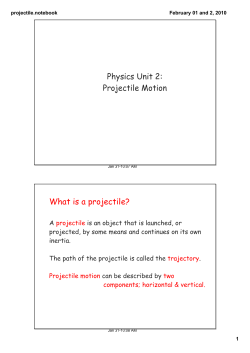
satellite motion - Fort Thomas Independent Schools
Projectiles,SATELLITES and Orbit Satellite and Circular Motion The path of an orbiting satellite follows the curvature of the Earth. Projectile Defined • Any launched object that moves through air or space under the influence of gravity. Horizontal Motion Associated with a Projectile • Objects launched horizontally continue in a horizontal direction a constant speed due to its inertia. Vertical Motion Associated with a Projectile • Object’s motion is accelerated due to the force of gravity (free falling!!) Projectile Motion Review How would you describe the downward motion of the two balls? What is an Earth Satellite? • A projectile that circles the Earth due to gravitational force. • Orbit occurs because the object moves fast enough to fall continuously towards the Earth and miss it. Horizontal vs. Vertical Motion for Satellites tangential velocity gravity (or rotational velocity) Note the curved projectile path! There is a balance between the tangential speed of the projectile and the force of gravity acting on the projectile Projectile Path Principles • The greater the object’s horizontal motion (or speed), the wider the arc of its curved path. • If thrown from the same height, both projectiles will land at the same time even if their horizontal speeds are different. See Figures 14.1 and 14.3 on page 263. Figure 4 b a 1) Label the arrows as gravity or sideways velocity. Place term inside box. 2) Which arrow represents centripetal force? 3) What would happen to the moon if the Earth’s gravity suddenly disappeared? Horizontal vs. Vertical Motion Orbital velocity gravity There is a balance between the orbital velocity of the projectile and the force of gravity pulling on the projectile (as the projectile pulls on the Earth) The Earth Curves A horizontal speed of 8 km/s will cause the projectile to become a satellite. Circular Orbits • A projectile with a speed of 8 km/s will orbit the Earth in a circle. A satellite in circular orbit is always moving perpendicular to gravity. Satellite’s Path • The shape of the path of a satellite is circular or elliptical (oval). An ellipse is a closed ovalshaped path. The Earth orbits the Sun in an ellipse! Circular and Elliptical Orbits • The cause for a projectile to orbit the Earth is the horizontal speed of the projectile. • Checking horizontal speed (tangential velocity) -Less than 8 km/s: no orbit -At 8 km/s: circular orbit develops -Greater than 8 km/s: elliptical orbit develops Orbit • A successful orbit occurs when the horizontal speed balances the downward acceleration of gravity. • The unbalanced force caused by gravity provides the change in velocity needed to keep the satellite turning. • Checking horizontal speed (tangential velocity) -Less than 8 km/s: no orbit -At 8 km/s: circular orbit develops -Greater than 8 km/s: elliptical orbit develops -escape velocity at 11.2 km/s Escape Speed • A vertical speed that is sufficient to ensure that the object will leave the Earth or whatever object from which the projectile is launched. CENTRIPETAL FORCE • The force that keeps an object going in a circle (means “toward center”). • Gravity, friction and pulling on a cord are examples of centripetal force. • You feel a push away from the center because of your inertia. • It takes a force to change your momentum. Centripetal Motion Applications • http://www.glenbrook.k12.il.us/gbssci/phys /mmedia/circmot/cf.html • http://www.glenbrook.k12.il.us/gbssci/phys /mmedia/vectors/sat.html • http://sol.sci.uop.edu/~jfalward/physics17/ chapter4/chapter4.html References • http://wwwistp.gsfc.nasa.gov/stargaze/Skeplaws.htm The Speed of Projectiles and Satellites • For projectiles and satellites, the speed of the object is related to differences in the two components of motion. References • http://wwwistp.gsfc.nasa.gov/stargaze/Skeplaws.htm
© Copyright 2025
















